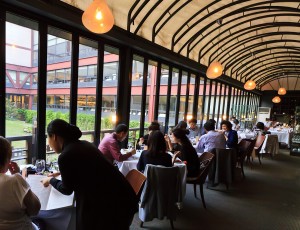 In the astonishing mix of ultra-modern and ancient found in Seoul’s Jongno-gu area is the Gyeonghui Palace, which is now the city’s Museum of History. Surrounded by corporate headquarters, government offices and embassies, the museum has a treasure of a different kind – the fine dining restaurant of Cong-du. This is a new-age destination restaurant best described as organic concept-art cuisine focused on Korean produce. It has a modern take on traditional tofu and bean-based dishes as every dish contains soy beans.
In the astonishing mix of ultra-modern and ancient found in Seoul’s Jongno-gu area is the Gyeonghui Palace, which is now the city’s Museum of History. Surrounded by corporate headquarters, government offices and embassies, the museum has a treasure of a different kind – the fine dining restaurant of Cong-du. This is a new-age destination restaurant best described as organic concept-art cuisine focused on Korean produce. It has a modern take on traditional tofu and bean-based dishes as every dish contains soy beans.
Cong-du has super-chic understated interiors and a glass encased terrace (with a remote-control retractable roof, allowing al fresco dining) overlooks the inner gardens of the former palace. What is presented in the menu is a direct contradiction to the serene surroundings as the neo-Korean cuisine is a venerable theme-park of traditional flavors brought together with multiple textures which nudge comic bursts of color and profound tastes into the 21st century. It’s a playful pop-art fusion in three fixed menus, each bombarding one’s palate with spicy, savory and sweet flavors – often simultaneously!
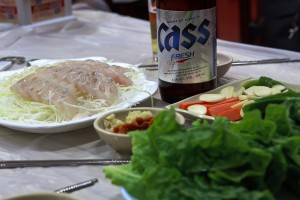 The three course ‘green’ menu begins with a Shepard’s purse and shrimp ball on spring herb salad with mulberry vinaigrette. The main options are steamed Jeju pork belly wrapped in Lotus leaves and served with black bean sauce or a Jinan tofu steak, which is lightly coated in sticky rice powder then gently fried and served with soybean chungukjang sauce and white gimchi chutney – a fresh and slightly sour relish. KWon 45,000/$38
The three course ‘green’ menu begins with a Shepard’s purse and shrimp ball on spring herb salad with mulberry vinaigrette. The main options are steamed Jeju pork belly wrapped in Lotus leaves and served with black bean sauce or a Jinan tofu steak, which is lightly coated in sticky rice powder then gently fried and served with soybean chungukjang sauce and white gimchi chutney – a fresh and slightly sour relish. KWon 45,000/$38
The five course ‘orange’ menu I chose included gold nugget squash soup with nut topping, steamed fresh cockles from the western wetland, Abalone with green sea sauce risotto, and silver cod marinated in dongukjang bisque sauce – a fermented soy and blue crab paste. KWon 70,000/$60
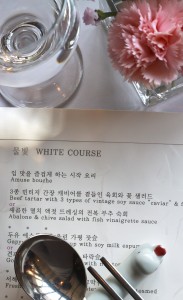
The six course ‘white’ menu my dinner guest selected started with a salty beef tartar drizzled with three types of vintage soy sauce and a flower salad, followed by a fragrant Gapyung pine nut soup – which is a blend of soy beans and pine kernels topped with soy milk and pine leaf oil foam. For mains it was sirloin steak with vintage soy sauce and caramelized garlic puree, followed by Jinji-sang, a simple Korean dish of rice crust and pickles. KWon 100,000/$85
All three menu options were perfectly completed with Cong-du’s special dessert plate comprising of cherry blossom shaped ginger honey cookies which comes with fried rice cake and star shaped tofu pudding.
It’s packed with locals, so booking is essential – and be sure to ask for a terrace table.
Cong-du Restaurant, Seoul Museum of History,
50 Saemunangil, 2-1 Shinmunro-2-ga, Jongno-Gu, Seoul 110-062
Tel +82 2 722 7002
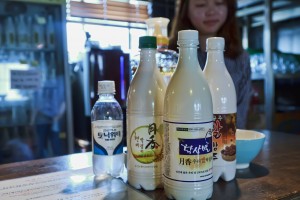
Soju is a distilled alcoholic beverage made from grain or sweet potatoes and varies in alcohol content from 16.7%, to about 45%. Drinking Soju in Korea has five etiquette pointers.
1. You must not fill your glass – someone else at your table should fill it for you. A glass should not be refilled unless completely empty and must be refilled quickly once empty.
2. In Korean culture, using two hands to offer and accept demonstrates respect. When receiving a drink, you should rest your glass in the left palm and hold it with the right hand, bowing your head slightly indicating additional respect to the server. It is common for the drink receiver to place the free hand not receiving the drink across his chest whilst bowing – an additional sign of respect. Among friends of equal social status, it’s not necessary to use both hands while pouring or receiving a drink, but may be done out of habit or politeness.
3. To pour a drink, you need to hold the bottle in the right hand, with the left hand touching the right forearm or elbow, holding back an imaginary sleeve. In the past, traditional Korean dress (hanbok) had long sleeves which would touch the table or drape in food – this is why sleeves are held back.
4. When clinking glasses, Koreans often say ‘one shot’ which is a challenge to everyone in the group to down their Soju in one gulp.
5. When drinking with elders, those younger in the group are expected to turn away when drinking as directly facing the elder is considered disrespectful.
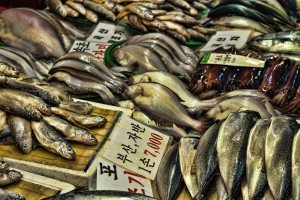
Noryangjin fish market is a cavernous and noisy warehouse where rubber-clad fishmongers beckon to passing potential custom. Blinding bright lights hang above rows of fish stalls and just about every edible sea creature out there. There are giant tubs of fermenting shrimp, Barbie-pink skate arranged like giant jewels and massive containers overfilled with flounder and sannakji – a local delicacy of octopus that’s taken fresh from the water, quickly gutted and expertly chopped into many pieces. Local custom demands that it be eaten whilst still writhing on the plate in its myriad parts.
Select your fish, mollusk or hairy mitten crab and take it to one of the many restaurants that line the perimeter of the market. The chef, after receiving instruction from you on how you’d like it prepared, will whisk your catch into the kitchen, prepare it then bring it out with all the condiments considered essential. I had my fish raw with fresh lettuce, perilla leaves, red pepper sauce, ssamjang paste (soya bean paste with chili and sesame oil) and slices of green pepper and garlic – ingredients that let the natural fish flavor shine through. While you dip and wrap your fillets of fish, the kitchen gets to work on making a spicy broth made from your fish bones.
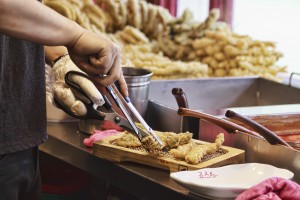
The entire nation is wild about tteokbokki – an addictive spicy snack made of cylindrically shaped rice cakes marinated in red chili paste and served traditionally with seasoned fish and egg or sometimes braised beef. Originally sold by street vendors, tteokbokki became a major branded product at the turn of the century. Since then, the market exploded with new tteokbokki franchise stores opening every day. Seoul has more restaurants per square block than anywhere else in the world – and none of them have an empty seat. Tteokbokkis are cheap and accessible, and by standardizing the tteokokki’s taste, offering an open air kitchen, a neat store interior and paying attention to packaging and sanitation, the branded tteokbokki shops are now hooking foreigners wary of traditional eateries. From the variety of foods displayed on the Tuk Tuk franchise menu, to simple Korean food offered by the numerous Jaws outlets (one step up from street vendor food), or the Pa Jeon, a green onion pancake of the Chaesun Dang franchise, there’s something new and unique on every street corner with each licensee having a different take on the menu.
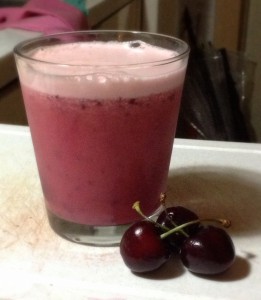
Makgeolli is a traditional Korean wine produced by mixing steamed rice and barley, or wheat with yeast and water, then leaving it to ferment a while. It has great cultural significance as it has a story deeply rooted in Korea’s history. It’s popular with young Koreans and expats owing to its reputation as a simple beverage that has numerous health benefits. Makgeolli is a milk-colored beverage (less than 7% alcohol content) with a mild peanut taste. It’s served in numerous hip bars (called ‘jujeoms’) in the Hongik University and Gangnam area. These jujeoms have taken to mixing Makgeolli with fresh fruit, resulting in a kaleidoscopic of eye-catching cocktails that are slightly sweet, refreshing and very tasty – similar to smoothies.
The Kiwi Makgeolli cocktail, for instance, contains 100ml tonic water, a squirt of honey, 3 tablespoons of brown Makgeolli, 6 tablespoons of white Makgeolli and half a Kiwi fruit. It’s all whizzed together in a food processor and poured into a cold bowl.
Makgeolli recipe courtesy of Kim Ena of the Walhyang Winebar – a makgeolli jujeoms in the Hongik University area.
Photo by mmpkorea.

